Fez is not an easy city: it's intense, noisy, chaotic, smelly, and at times overwhelming. Don't arrive expecting comfort or order; you have to be willing to observe, listen, and let yourself be carried away by its own rhythm. Visiting Fez is like immersing yourself in one of the most vibrant cities in North Africa.
With over a thousand years of history, it was the cultural and spiritual capital of Morocco for centuries, and its medina, a medieval labyrinth declared a World Heritage Site, remains a place where time seems to stand still. If you let yourself go, Fez rewards you with history, ancient architecture, exquisite cuisine, and a cultural journey that will surely be etched in your memory.
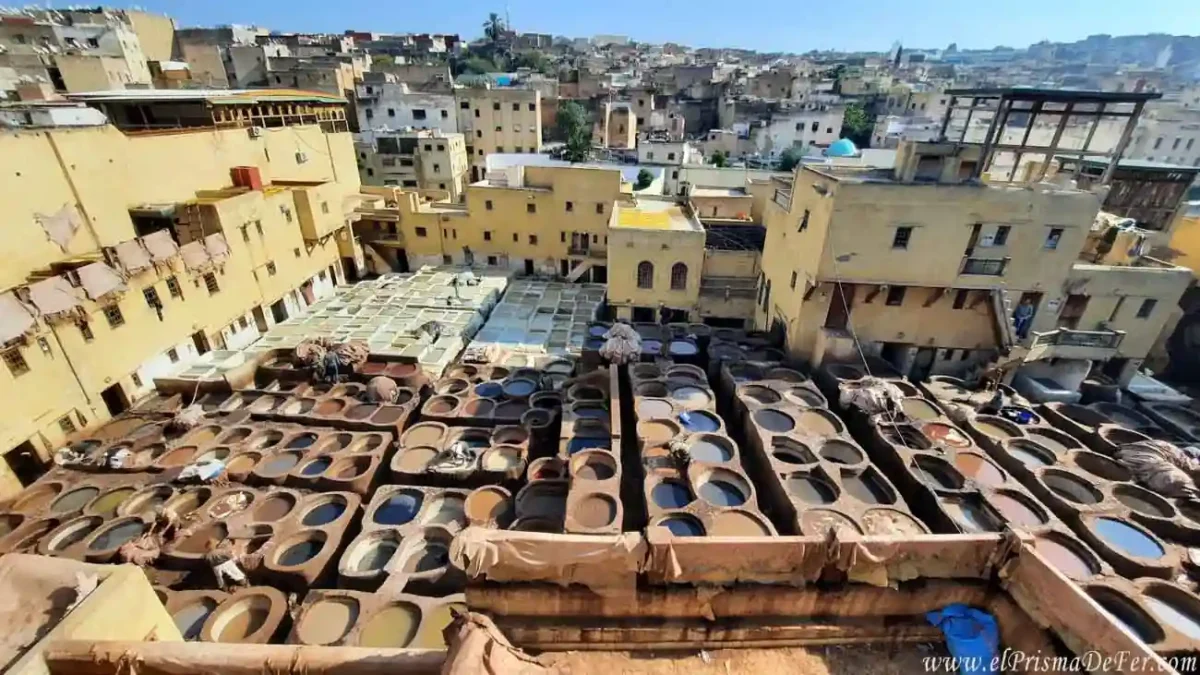

Table of Contents
Arriving in Fez from Chefchaouen
I arrived in Fez from Chefchaouen, after spending a few days trekking in the Rif Mountains. The contrast couldn't have been more abrupt: I went from the blue, silent peace of that mountain town, where the pace of life is slow and relaxed, to the vibrant, chaotic intensity of Fez, with its crowded medina, calls to prayer echoing everywhere, and a whirlwind of stimuli around every corner. It was a real sensory shock, overwhelming at first, but over time becoming part of the allure.
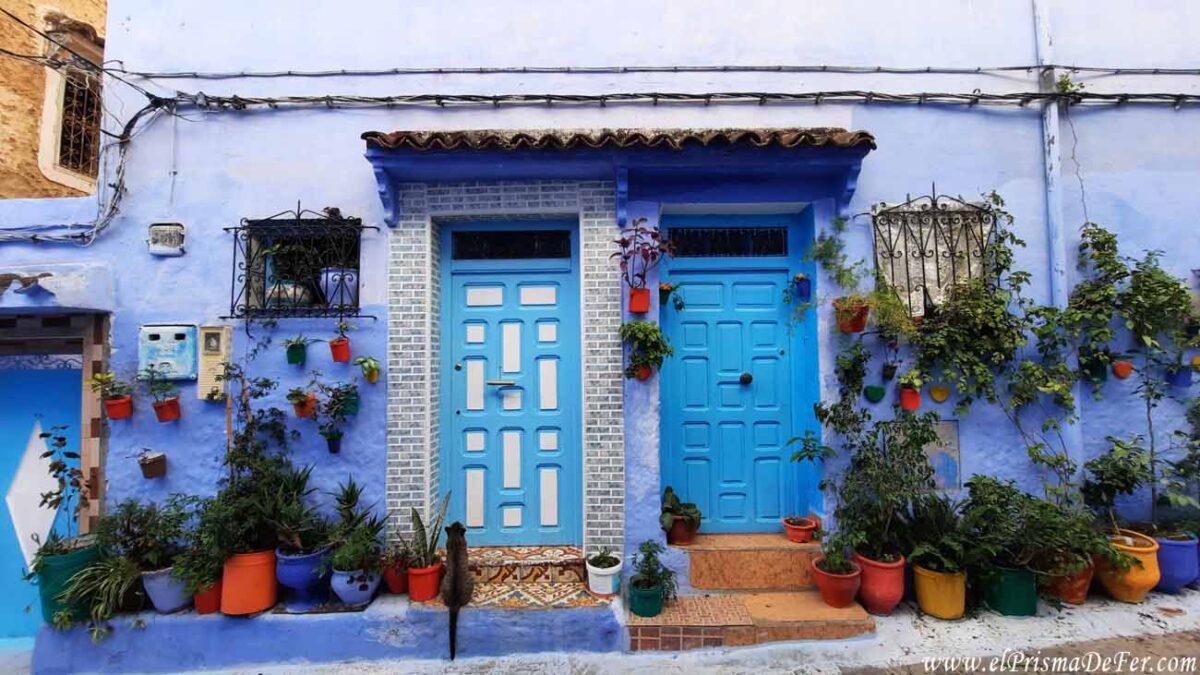
You can now read the guide to visiting the Blue Pearl of the North of Morocco, Chefchaouen
How to get to Fez from different cities in Morocco (and from abroad)
Fez, in addition to being one of Morocco's four imperial cities, is very well connected by rail and road to the country's major cities. Getting there is quite easy, whether you're already traveling within the country or coming from abroad.
From Marrakech
There are comfortable trains that take between 6 and 8 hours. See schedules and prices at ONCF. The main train station is Fès-Ville, well connected to the national network.
There are also buses that take a little longer, between 7 and 9 hours, with companies such as CTM or Supratours.
From Chefchaouen
This is a medium-length trip. There are direct buses that take between 4 and 5 hours. Check the CTM or Supratours websites for more information.
From Merzouga
If you're coming from Merzouga, you can also take one of the buses operated by the aforementioned companies. These trips take approximately 9.45 hours. They are usually overnight trips, ideal for saving a night's accommodation.
From the outside
Fez has an international airport, Fès–Saïss Airport (FEZ), which receives flights from several European cities. You can get to the city center from the airport by taxi (negotiable fare) or by public bus, although the latter is less frequent.
How to get from Fez Airport to the city center
- Public Bus (Line 16): Connects the airport to Fez train station. The journey takes approximately 40 minutes and costs between 3 and 4 dirhams.
- Taxi: There are taxis outside the airport, but it is advisable to set the fare in advance, as the use of taximeters is not common.
If you don't want to complicate things and prefer convenience, you can book a private transfer from this link.
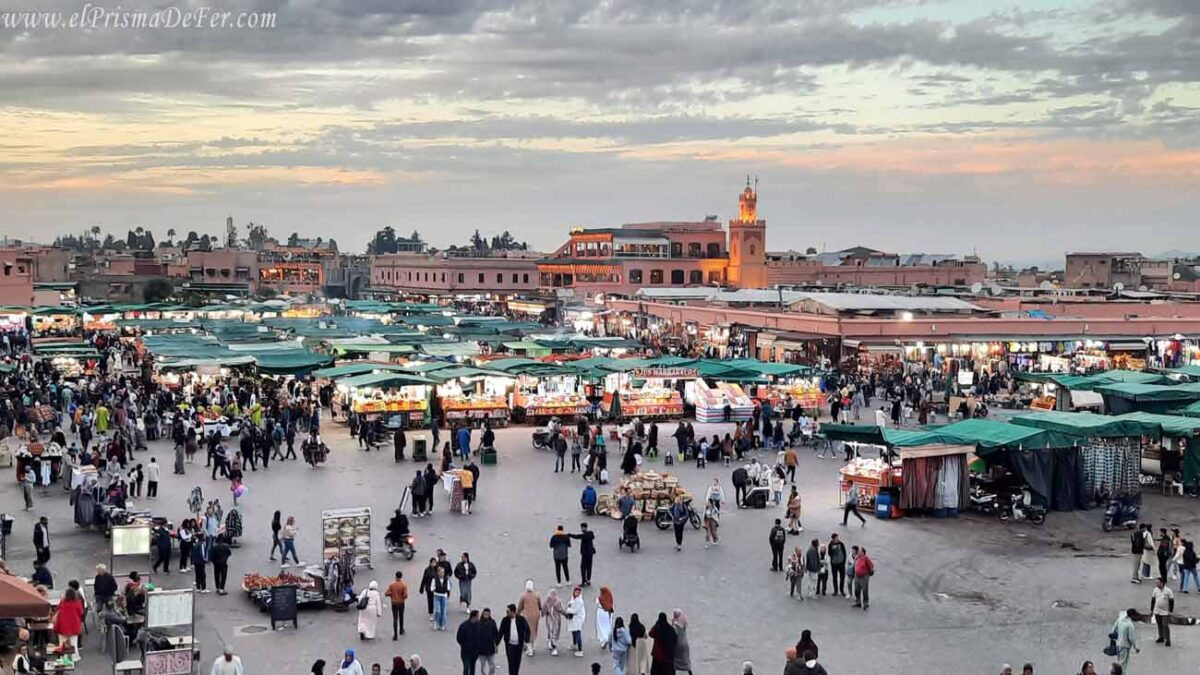
You can read the complete travel guide to Morocco. There you have all the information you need to plan your trip to this fantastic country.
Some curiosities about Fez
🧠 Did you know that Fez is home to the oldest university in the world?
The University of Al-Qarawiyyin, founded in 859 AD by a woman, Fatima al-Fihri, is recognized by UNESCO and Guinness World Records as the oldest continuously operating educational institution in the world.
🧴 The smell of Fez is also a heritage
The Chouara tanneries, with over a thousand years of history, use pigeon droppings, lime, and natural dyes to treat the leather. The smell is so strong (and unpleasant) that vendors give you mint to help you endure it. It's disgusting but striking at the same time.
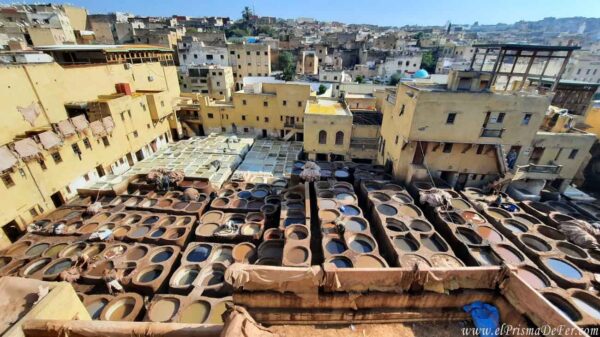
This post is part of the itinerary I put together for a 3- or 4-week tour of Morocco. If you'd like to see the full details, you can read the main article here.
🧭 The medina of Fez is a true labyrinth
With more than 9,000 alleyways, many of them dead ends, Fez el-Bali is the world's largest pedestrian zone. Google Maps often doesn't work there, and getting lost is almost part of the plan.
🕌 Fez had its own “medieval Wi-Fi” system
In centuries past, a network of foot messengers connected madrasas, mosques, and markets to transmit news, official announcements, and religious events. All with precision and without technology.
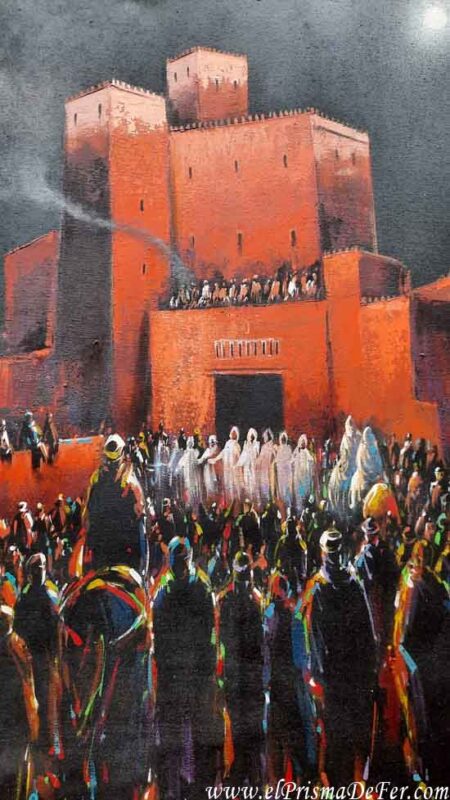
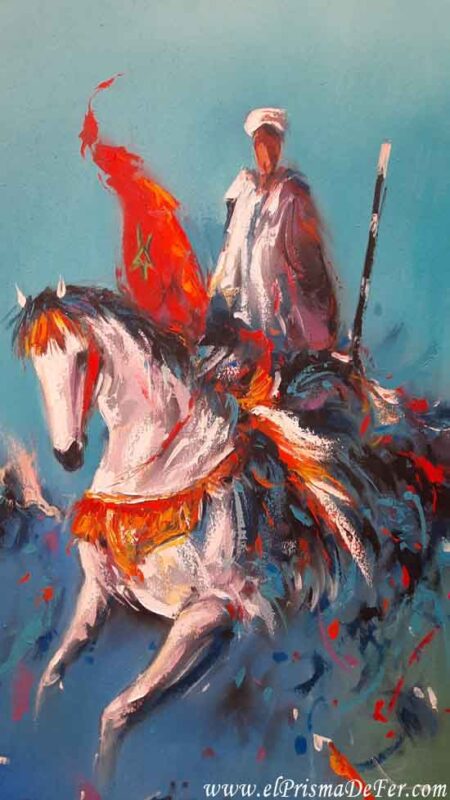

Map of Fez attractions
📍 What to do in Fez: living history in every corner
Fez is one of the imperial cities of Morocco, and its medina, Fez el-Bali, is the largest pedestrian medieval city in the world. Founded in the 8th century, it reached its peak in the Middle Ages as the spiritual, cultural, and commercial center of North Africa. Strolling through Fez isn't just sightseeing: it's walking through centuries of living history.
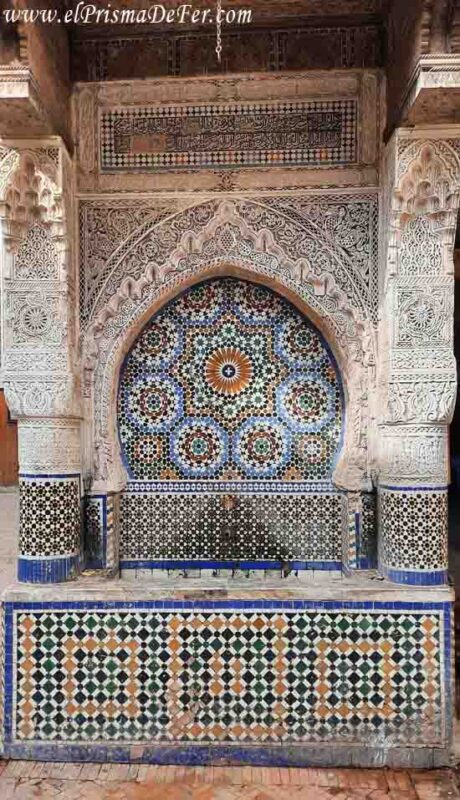
Here are some unmissable experiences:
🕌 Perderse en la Medina de Fez el-Bali
The Fez medina has been a UNESCO World Heritage Site since 1981. With more than 9,000 alleys and no cars or the annoying motorbikes that plague the Marrakech medina, it's an experience in itself: overwhelming and captivating. Full of life, colors, and (sometimes not so pleasant) aromas, walking through it is a trip back in time.
Inside the medina you can't miss:
- Bab Bou Jeloud (The Blue Gate): Main entrance to the medina, built in 1913, with one side blue (the color of Fez) and the other green (the color of Islam).
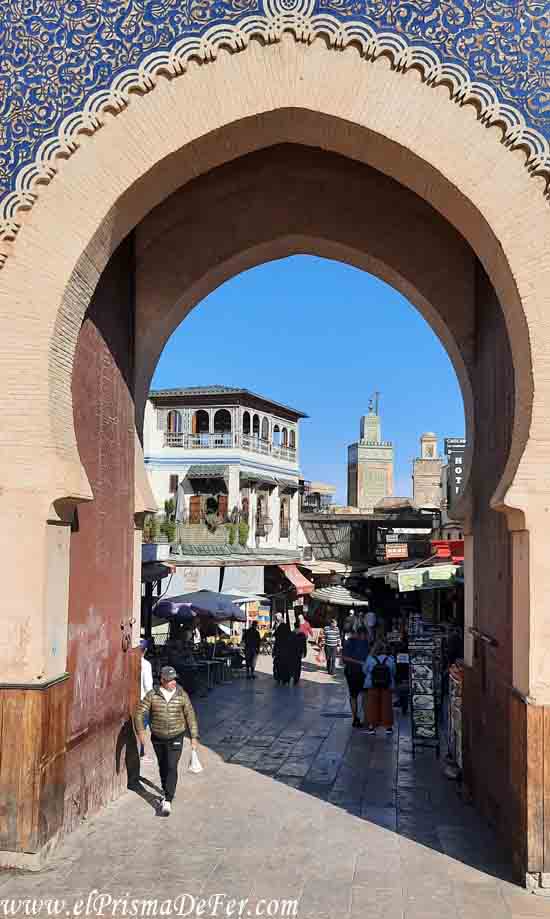
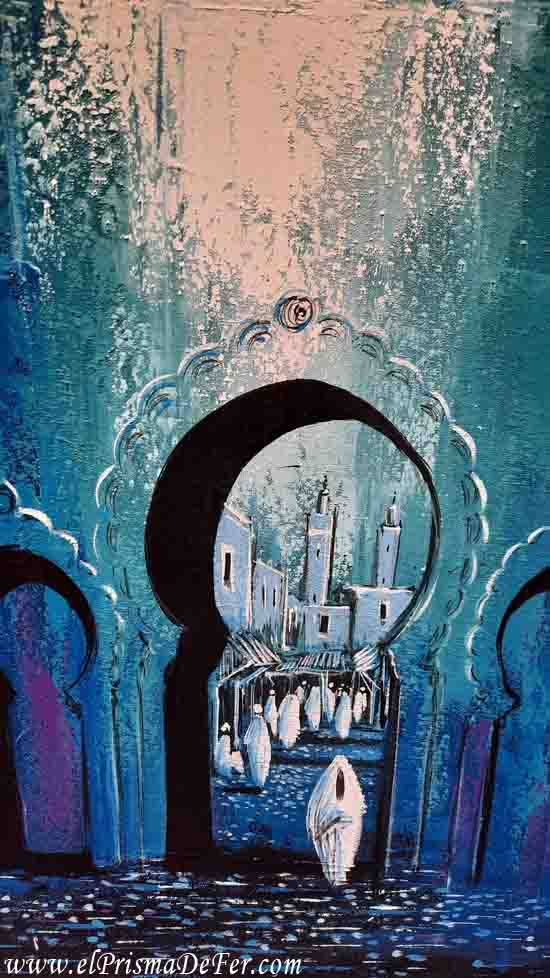
- Talaa Kebira and Talaa Sghira Streets : The two main arteries. Along these streets you'll find shops, bakeries, spice stalls, antique bookstores, and hidden riads.
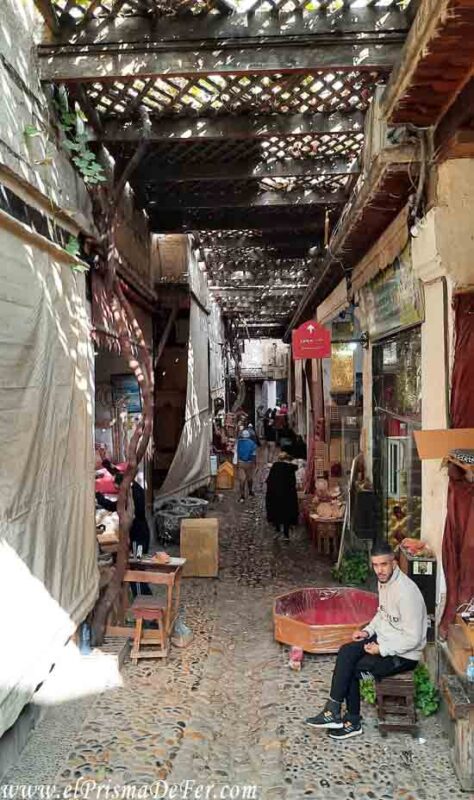
- Traditional souks: Spice, textile, ceramic, brass, and leather goods souks. Each guild has its own area, just like in the Middle Ages.
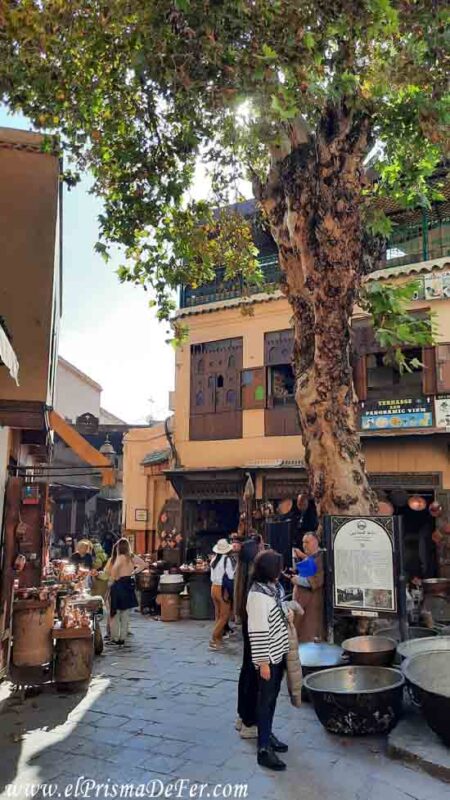
👣 Take a free walking tour of the medina
If there's one place where it's worth taking a free walking tour, it's Fez. The medina is so full of history, symbolism, and hidden corners that walking through it without context is like flipping through a book in another language.
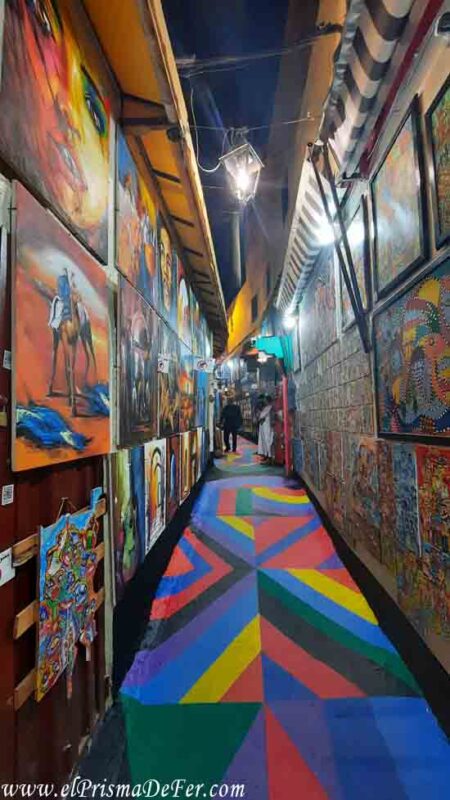
In my case, I took a free tour on the second day, and it was a very good decision. Honestly, I don't usually take many walking tours, but I realized on the first day that I was walking from one place to another without any background on where I was. So this time, I didn't hesitate. The guide not only showed us the most important places in the medina, such as the tanneries, madrasas, squares, and historic gates, but also explained fundamental aspects of Moroccan culture, Islam, and how these beliefs are intertwined with everyday life.
He spoke to us about the five pillars of Islam, the importance of the call to prayer, why not all religious spaces are accessible to non-Muslims, and how religion even influences the way Moroccans trade and hospitality.
A good free tour (even if they're not actually free) in Fez not only orients you within the labyrinth of the medina, but also places you culturally and spiritually within the world you're exploring. Most end with a voluntary contribution and are worth every dirham.
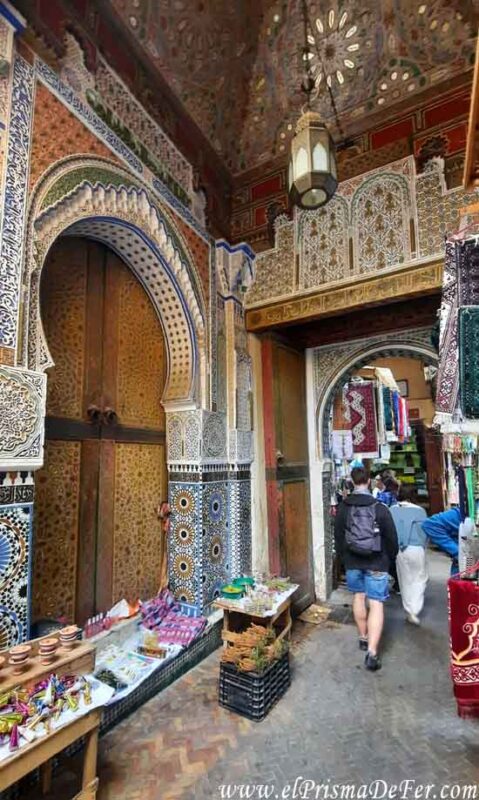
These tours typically start at Bab Bou Jeloud and last between 2 and 3 hours. A voluntary (but fair) tip is left for the guide at the end. Options are available in English, Spanish, and French, depending on the day.
Visit the Chouara Tanneries
These tanneries, dating back to the 11th century, are a feast for the senses, especially your sense of smell. From the balconies of the leather shops, you can see the vats of lime, pigeon droppings, and natural dyes like indigo and saffron. It's incredible to see how, in the 21st century, they continue to tan leather as they did a thousand years ago.
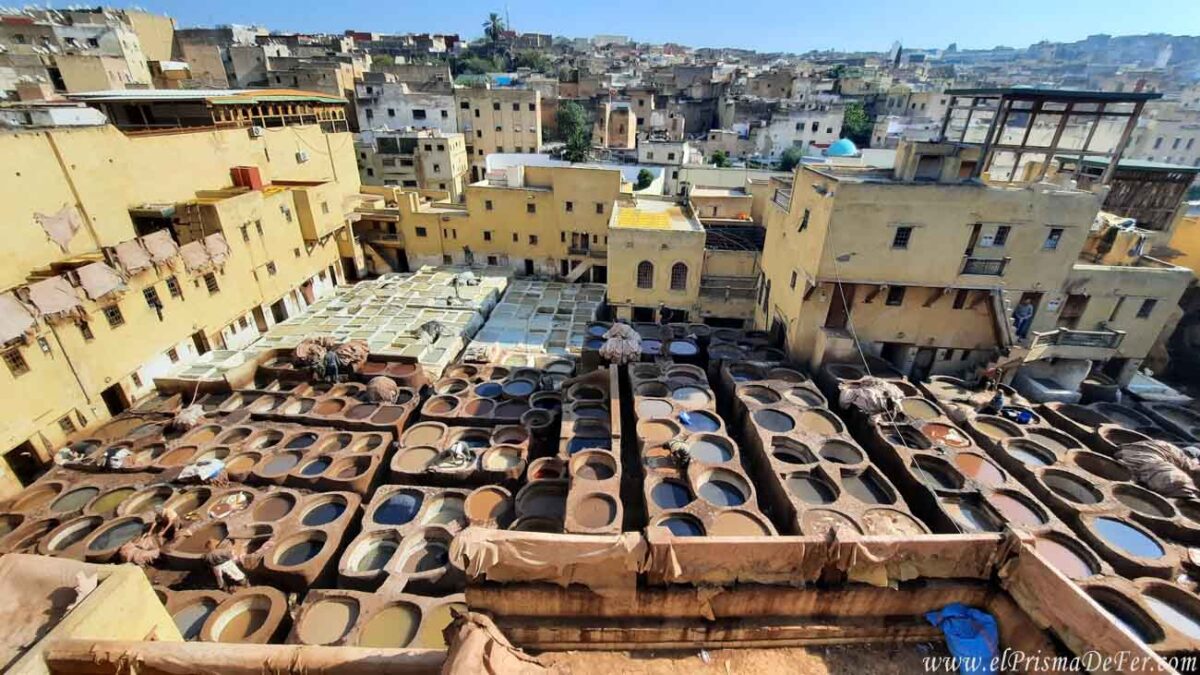
The other side of tanneries
Beyond the visual and photographic appeal of the leather tanneries of Fez, there is a harsh reality that often goes unnoticed: the working conditions are extremely unhealthy. Workers labor for hours submerged in mixtures of lime, excrement, and dyes, often without gloves or adequate protection. The smell is so strong that even visitors are offered mint leaves to endure it, but those who work there do so every day, exposed to chemicals that irritate the skin and affect the respiratory tract. It is a traditional trade that has remained almost intact for centuries, but at a high human cost, which invites us to look beyond the tourist exoticism.
🕌 Bou Inania Madrasa
Built in the 14th century by the Marinid sultan Abu Inan Faris, this madrasa is an architectural gem and one of the few in Morocco open to non-Muslims. Its stucco, marble, and carved cedar wood decoration is spectacular. It was a religious school, but also functioned as a mosque and astronomical observatory.
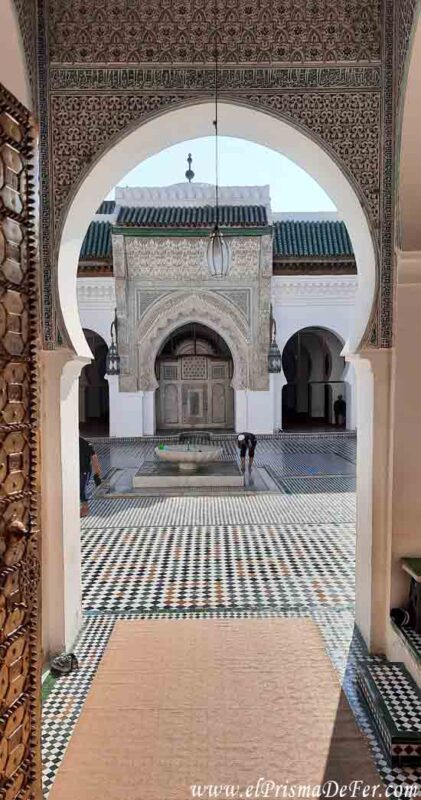
📖 Al-Qarawiyyin: the oldest university in the world
Founded in 859 AD by a woman, Fatima al-Fihri, the University of Al-Qarawiyyin is recognized by UNESCO and Guinness World Records as the oldest university still in operation. Although the mosque and library are only open to Muslims, you can see the exterior and feel the historical weight of the place.
🛕 Mausoleum of Moulay Idriss II
Shrine dedicated to the city's founder, Moulay Idriss II, considered a saint by many Moroccans. Although access is restricted to non-Muslims, the facade and surrounding atmosphere are very special.
📸 Viewpoints and rooftops
For a break from the chaos of the medina, you can climb to one of its many rooftops or visit:
- The Merinid Tombs: Ruins on the hill overlooking Fez el-Bali. The views are spectacular, especially at sunset.
- Borj Nord: An ancient 16th-century fortress built by the Saadians. Today it houses a weapons museum and also has an impressive viewpoint.
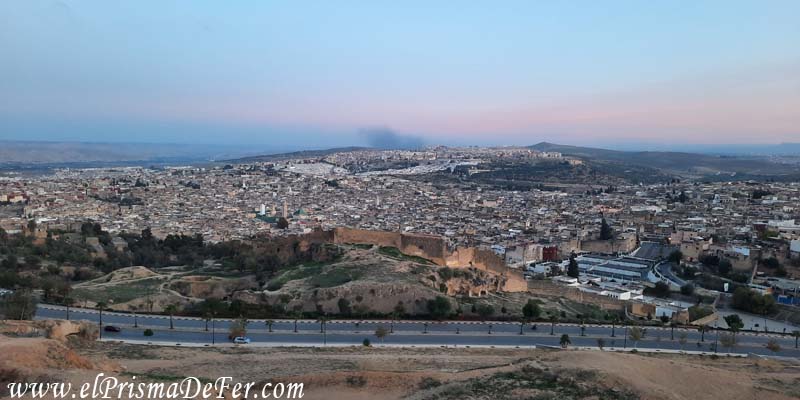
🛁 Experience a traditional hammam
Nothing beats a Moroccan bath after hours of walking through the medina. You can try a traditional public hammam (more local and affordable), or one in a riad or spa for a more relaxing experience.
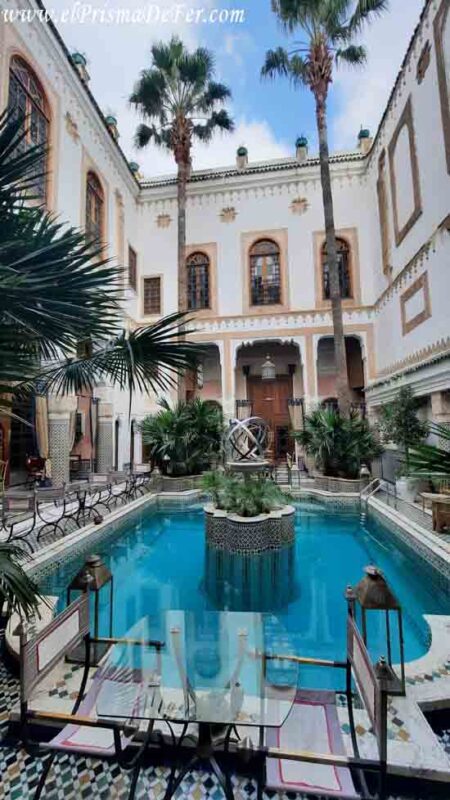
🍽️ Taste the cuisine of Fez
Fez cuisine is considered the most refined in Morocco, a legacy of centuries of Andalusian, Berber, and Arab tradition. Trying it is an essential part of any trip. Don't miss dishes such as:
- Chicken pastilla with almonds and cinnamon: a delicious contrast between sweet and savory.
- Tajines: lamb with prunes, chicken with pickled lemon or spiced vegetables.
- Harira: thick soup with lentils, chickpeas and spices, typical during Ramadan.
- Dates, honey sweets and the inevitable mint tea.
Street food is also part of the charm... but be careful.
In my case, I was tempted by a kind of red sausage sold at a street stall in the medina, on one of the main streets. It looked interesting. However, a few hours later, I ended up with an upset stomach that kept me ailing for several days.
Tip: Although local food is often delicious, it's best to look closely at the stall's appearance, whether there's a lot of locals eating there, and whether the food is cooked properly or at the right temperature. Not everything that smells good... goes down well.
🏞️ What to do in Fez beyond the medina
Although the medina is the historical and cultural heart of Fez, exploring outside its walls also reveals other facets of the city: from multicultural neighborhoods to tranquil parks and historic buildings.
✡️ Visit the Jewish Quarter (Mellah)
The Mellah of Fez, located in the Fez el-Jdid area, was the first Jewish quarter established in Morocco in the 15th century. Although today most of its inhabitants are not Jewish, the place retains a very particular atmosphere.
- Streets with wooden balconies (something unusual in Moroccan architecture).Streets with wooden balconies (something unusual in Moroccan architecture).
- The Ibn Danan Synagogue, restored and open to the public, is a hidden gem and a testament to the ancient coexistence between Jewish and Muslim communities.
- The Jewish cemetery, just behind the Mellah, is one of the oldest and largest in the country.
🌳 Relax in the Jnane Sbil Garden
If you need a break after walking through the medina, the Jnane Sbil Garden is the place for you. Located between Fez el-Bali and Fez el-Jdid, this Andalusian-style park offers shade, fountains, flowers, an artificial lagoon, and peaceful paths where you can sit, read, or simply take a break from the hustle and bustle.
It was designed in the 18th century by Sultan Moulay Abdallah and restored a few years ago. It is popular with locals, especially at sunset.
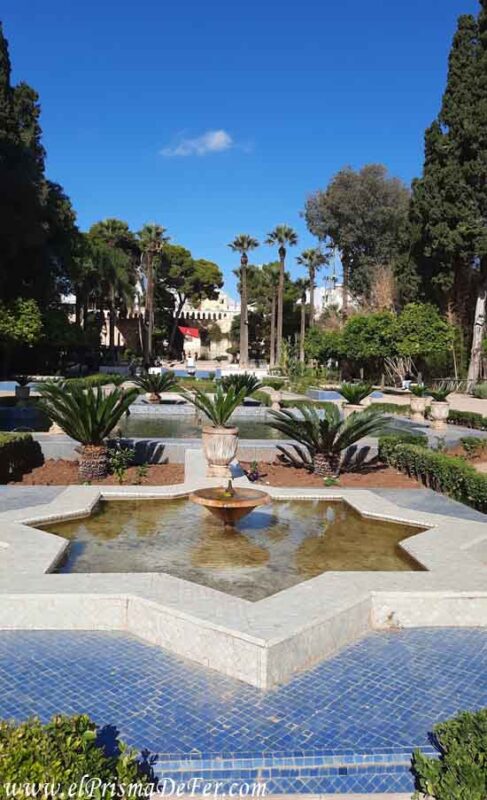
🏛️ Explore Fez el-Jdid and its walls
Fez el-Jdid was founded in the 13th century as an extension of the city to house the Royal Palace (Dar el-Makhzen) and the administrative quarters. Although the palace is not open to the public, its main gatehouse is monumental, with massive gilded doors, glazed tiles, and carved wood.
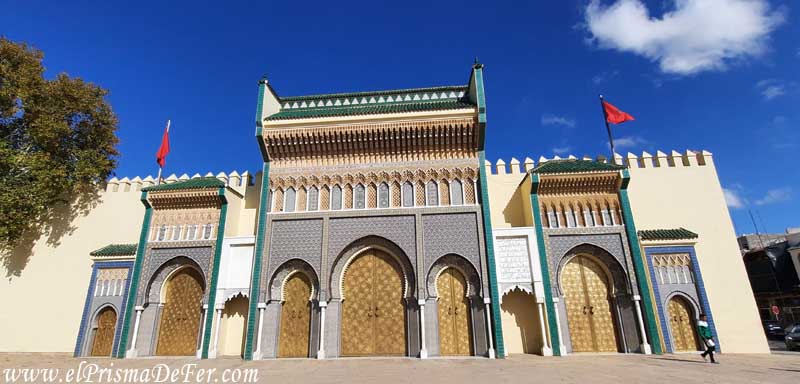
Nearby are:
- The defensive wall and several bastions that protected the city.
- The military quarter, which displays a more sober and functional architecture.
🖼️ Nejjarine Museum of Wood Arts and Crafts
Technically within the medina, but worth a separate mention. Located in a restored old funduq (caravanserai), this museum is perfect for understanding Fez's artisan tradition: carpentry, inlays, antique tools, and decorative objects. It also has beautiful architecture and a panoramic terrace.
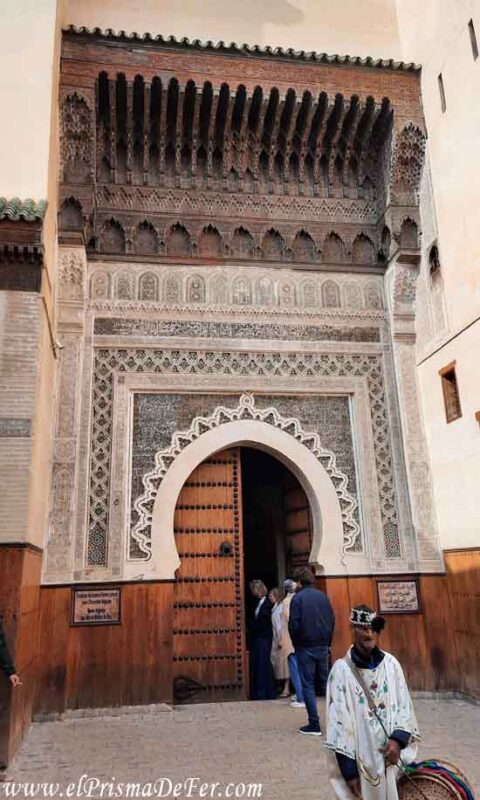
🕌 Dar Batha (Museum of Moroccan Arts)
A former palace converted into a museum, with collections of ceramics, textiles, manuscripts, and Islamic art. Although it has been closed for renovations, it's worth checking to see if it's open.
Activities organized in Fez
The tours I recommend in this section contain affiliate links. This means that if you book through them, I receive a small commission at no extra cost to you. It's a way to support my work and help me keep this space alive, filled with stories and travel advice. Thanks for joining me along the way ;)!

🏨 Where to stay in Fez
Fez is a city with soul, and the ideal place to stay is a place that allows you to experience it from the inside. The best area to stay is within the medina (Fez el-Bali) , especially if it's your first time in the city. Traditional riads abound here, restored Moroccan houses with interior courtyards, mosaics, and an authentic atmosphere that transports you back centuries.
For a quieter experience, you can opt for accommodation just outside the medina, in the Fez el-Jdid or Ville Nouvelle areas, where there are modern hotels and a bit more urban order.
I stayed in the medina at the very picturesque Hostel Speakeasy Fes. The interior decor is the best :).
🛡️ Is it safe to travel to Fez?
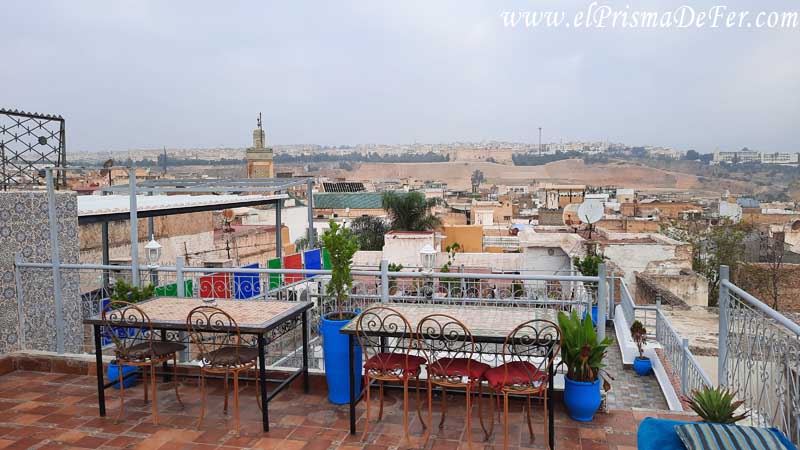
Overall, Fez is a safe city for travelers, but as with many ancient medinas in the Arab world, you should move around with some caution, especially at night.
During the day, the medina is bustling with merchants, tourists, and locals, and walking through its narrow alleys is an interesting experience. However, at night the atmosphere changes: many streets are empty, poorly lit, and the atmosphere can feel intimidating, especially if you're alone.
In my case, it was the only place in Morocco where I truly didn't feel entirely safe: one night, without a clear direction, I wandered into the alleyways of the medina and ended up disoriented. Although nothing happened to me, the feeling of isolation, the suspicious glances of the few people I passed, and the difficulty in finding one of the busiest streets made me think twice before going out again the next day.
Tips for moving safely in Fez:
- Avoid walking alone through the medina at night, especially without a clear destination.
- Enter the name and exact location of your accommodation, or save it to Google Maps.
- Do not display valuables unnecessarily.
- If you get lost, ask for help in a store or restaurant rather than ask strangers in empty alleys.
That said, Fez is not a dangerous city, but it is a place where you should be more cautious than in other Moroccan cities such as Marrakech or Rabat.
⏳ How many days to stay in Fez
Ideally, you should dedicate at least 2 or 3 full days to Fez. One day to thoroughly explore the medina, another for the surrounding areas or more leisurely visits, and a third if you want to take it easy, do some shopping, or relax in a traditional hammam.
If you have time, you can use Fez as a base for a trip to the imperial city of Meknes, Volubilis (Roman ruins) or the charming Ifrane, all just a few hours away.
🗓️ 3-Day Itinerary in Fez, Morocco
🕌 Day 1 – First encounter with the medina and guided tour
- Free Walking Tour of the medina (Fez el-Bali). Ideal for initial orientation and historical context.
- Visit to places such as the Bou Inania Madrassah, the Nejjarine Fountain and a panoramic view of the Chouara Tannery.
- Lunch in a traditional restaurant
- Self-guided tour of the medina souks: Attarine Souk (spices), Seffarine Souk (copper), and carpet shops.
- If you still have energy, explore the medina's nightlife, with caution, especially if you're alone.
✡️ Day 2 – History, culture, and the lesser-known Fez
- Visit to the Jewish Quarter (Mellah) and the Ibn Danan Synagogue.
- Photo of the impressive golden gate of the Royal Palace (although you can't visit the inside).
- Lunch in the modern area or near the park.
- Take a stroll through the Jnane Sbil Garden to relax a bit.
- If it's open, visit the Dar Batha Museum or the Nejjarine Museum.
🌄 Day 3 – Lookouts, views, and local experiences
- Climb to the Miradores del Borj Nord or Borj Sud for panoramic views of the medina.
- Visit the Tomb of the Merinids, among ruins and open landscapes.
- Last minute purchases in the medina: spices, pottery, leather goods, or souvenirs.
- You can end your trip with a tasting menu or something more relaxing, depending on your energy level.
Some video captures from Fez
Final thoughts on my visit to Fez
Fez is, without a doubt, a historical gem. Walking through its medina is like stepping into centuries of tradition, Islamic architecture, artisan life, and spirituality. But I also felt, and I think it's worth saying, that it's not a city for every traveler. At times, Fez can feel stifling, intense, and even overwhelming: the strong smells from the tanneries, the lack of open spaces within the medina, and the constant feeling of being lost can make the experience exhausting.
Unlike Marrakech, whose medina is dotted with squares, gardens, and spaces to stop and breathe, Fez sometimes feels like it's all alley after alley. But perhaps that's part of its character: a city that doesn't seek to please you, but rather challenges you to understand it. And while it may not be the easiest to love, it certainly leaves its mark.
Support The Prism of Fer!
Your support helps me continue creating free content on the blog. Thank you so much!

